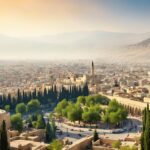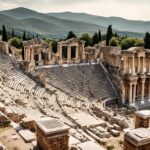The city of Damascus, located in Syria, is a historical treasure that has stood the test of time. With a rich history dating back to the 3rd millennium B.C., it is one of the oldest cities in the Middle East. Known for its cultural heritage and ancient beauty, Damascus continues to captivate visitors from around the world.
In biblical times, Damascus held great significance. It is mentioned multiple times in the Bible and is associated with notable figures such as Abraham, Elijah, and Saint Paul. The city’s role in the spread of Christianity after the conversion of Saint Paul marked a significant turning point in its history.
During biblical times, Damascus was a thriving city with a flourishing craft industry. It was renowned for its sword production and lace-making, which contributed to its economic prosperity. The city was also home to the impressive Great Mosque of the Umayyads, built on the site of an Assyrian sanctuary.
Several major biblical events took place in Damascus, leaving a lasting impact on its history. The conversion of Saint Paul to Christianity marked a significant shift in the region’s religious landscape. Damascus continued to play a role in the development of early Christian communities and the spread of the faith.
Today, despite the ongoing conflicts in Syria, Damascus remains a cultural and historical hub. The city attracts tourists who are drawn to its ancient beauty, bustling markets, and well-preserved historical buildings. Visitors can immerse themselves in the rich traditions, craftsmanship, and vibrant cultural scene of this ancient city.
Key Takeaways:
- Damascus is one of the oldest cities in the Middle East, with a history dating back to the 3rd millennium B.C.
- The city holds biblical importance and is associated with notable figures such as Abraham, Elijah, and Saint Paul.
- In biblical times, Damascus had a thriving craft industry and was known for sword production and lace-making.
- Major biblical events, such as the conversion of Saint Paul, had a lasting impact on the city’s history.
- Despite ongoing conflicts, Damascus continues to attract tourists with its ancient beauty and cultural heritage.
The Biblical Significance of Damascus
The ancient city of Damascus holds great biblical importance, with numerous mentions in the Bible. It is believed to have existed before recorded history and has strong connections to notable biblical figures such as Abraham, Elijah, and Saint Paul. These ties to biblical history make Damascus a city of immense cultural and religious significance.
One of the most pivotal events in biblical history that took place in Damascus was the conversion of Saint Paul to Christianity. Prior to his conversion, Paul, then known as Saul, was a persecutor of Christians. However, while on a journey to Damascus, he had a transformative encounter with Jesus Christ, which led to his conversion. This event marked a significant turning point in both Paul’s life and the spread of Christianity, making Damascus a crucial site in early Christian history.
In biblical times, Damascus was a thriving city known for its flourishing craft industry. It was renowned for producing swords and lace, which contributed to its economic prosperity. The city was also home to an Assyrian sanctuary, which later became the site of the impressive 8th-century Great Mosque of the Umayyads.
Table: Key Biblical Events in Damascus
| Event | Significance |
|---|---|
| Abraham’s Encounter | Believed to have met the high priest Melchizedek in Damascus, establishing his place in biblical history. |
| Elijah’s Refuge | After fleeing from Jezebel, Elijah found refuge in Damascus, highlighting the city’s importance in biblical narratives. |
| Saint Paul’s Conversion | Paul’s conversion on the Road to Damascus transformed him into one of Christianity’s most influential figures. |
Today, Damascus stands as a symbol of resilience and endurance. Despite the ongoing conflicts in Syria, the city continues to attract visitors from around the world who are drawn to its ancient beauty and rich biblical heritage. Exploring the streets of Damascus, one can still find remnants of its biblical past, from ancient architecture to vibrant markets that have stood the test of time.
As we delve further into the wonders of Damascus, we will continue to discover the architectural treasures, cultural traditions, and the enduring spirit of this ancient city.
Damascus in Biblical Times
In biblical times, Damascus was a bustling city with a thriving craft industry. It played a significant role in the region and held great importance both culturally and economically. Let’s delve into how Damascus looked and functioned during this time.
The City of Damascus
Damascus, situated in modern-day Syria, was renowned for its skilled craftsmen and their exceptional products. The city was known for its production of swords and lace, which contributed to its economic prosperity. The swords made in Damascus were highly sought after for their superior quality and distinct patterns.
“Damascus had a flourishing craft industry, with artisans producing swords and lace of exceptional quality.”
In addition to its craftsmanship, Damascus boasted a prominent architectural landmark—the Assyrian sanctuary. This sanctuary later became the site of the magnificent 8th-century Great Mosque of the Umayyads, which stands as a testament to the city’s rich history.
Notable Biblical Figures
Damascus holds biblical significance, as it is mentioned multiple times in the Bible. It is believed to have existed even before recorded history. Several notable biblical figures are associated with Damascus, including Abraham, Elijah, and Saint Paul. Their stories and encounters in the city have left a lasting impact on its history and cultural heritage.
“Damascus is linked to biblical figures such as Abraham, Elijah, and Saint Paul, further enhancing its biblical importance.”
Summary:
In biblical times, Damascus was a thriving city known for its craftsmanship and architectural marvels. The production of swords and lace contributed to its economic prosperity, and the city’s importance is further enhanced by its association with notable biblical figures. Damascus continues to be a place of great historical and cultural significance to this day.
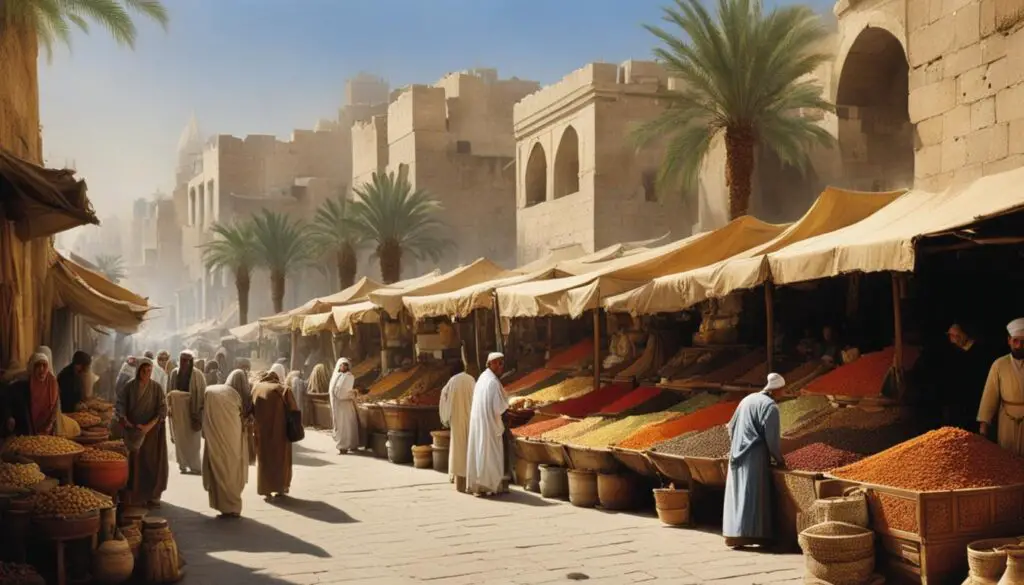
| City | Craft Industry | Architectural Landmark |
|---|---|---|
| Damascus | Swords and lace production | Assyrian sanctuary |
Major Biblical Events in Damascus and Their Impact
Damascus, an ancient city with a rich biblical history, played a pivotal role in several major events that shaped the region and impacted its history. These events not only influenced the religious landscape but also left a lasting impact on the culture and development of Damascus as a city.
The Conversion of Saint Paul
One of the most significant biblical events that took place in Damascus was the conversion of Saint Paul. According to the Bible, Saul of Tarsus, later known as Saint Paul, was on his way to Damascus to persecute Christians. However, during his journey, he had a transformative experience where he encountered a blinding light and heard the voice of Jesus. This encounter led to his conversion to Christianity and marked a turning point in his life and the spread of Christianity.
This event had a profound impact on Damascus as well. With the conversion of Saint Paul, Christianity gained a prominent foothold in the city, further spreading the teachings of Jesus and establishing early Christian communities. The conversion of Saint Paul not only transformed the religious landscape of Damascus but also contributed to the growth and development of Christian communities in the region.
The Impact on History
The conversion of Saint Paul in Damascus had a lasting impact on the history of the city and the region as a whole. It marked the beginning of a significant shift in religious beliefs, paving the way for the establishment of Christianity as a major religion in the region. The growth of Christian communities in Damascus played a crucial role in shaping the cultural and social fabric of the city over the centuries.
Furthermore, the conversion of Saint Paul and the subsequent spread of Christianity in Damascus created a strong connection between the city and the early Christian Church. Damascus became an important center for the development of Christian theology, attracting notable theologians and scholars. The influence of Damascus in the Christian world continued to grow, leaving a lasting legacy that is still felt today.
In conclusion, Damascus witnessed major biblical events, particularly the conversion of Saint Paul, which had a profound impact on the city’s history and the religious landscape of the region. These events not only transformed the city into a hub for Christianity but also contributed to the development of early Christian communities. The impact of these events can still be seen and felt in Damascus today, making it a significant destination for those interested in exploring its biblical history.
Architecture and Landmarks of Damascus
As one of the oldest cities in the Middle East, Damascus boasts a rich architectural heritage that showcases its ancient beauty. The Umayyad Mosque, also known as the Great Mosque of Damascus, is a standout landmark in the city. Built in the 8th century on the site of an Assyrian sanctuary, this magnificent structure is renowned for its stunning architecture and intricate design.
The Umayyad Mosque features a beautiful courtyard adorned with marble columns and a striking prayer hall adorned with golden mosaics. The mosque’s minaret, known as the “Minaret of Jesus,” stands as a symbol of both Islamic and Christian influence in Damascus.
Another notable architectural gem in Damascus is the Azm Palace. This well-preserved palace showcases traditional Damascene architecture and offers visitors a glimpse into the opulent lifestyle of the city’s ruling elite during the Ottoman period.
“The Umayyad Mosque is a testament to the architectural prowess and rich history of Damascus. Its intricate design and stunning mosaics are a true marvel.” – Local historian
The Umayyad Mosque – A UNESCO World Heritage Site
The Umayyad Mosque holds such cultural and historical significance that it has been recognized as a UNESCO World Heritage Site since 1979. This designation highlights the importance of preserving this architectural masterpiece for future generations to appreciate and admire.
| Architecture | Significance |
|---|---|
| Majestic domes and arches | Symbolic of Islamic architecture |
| Exquisite mosaic artwork | Reflects the craftsmanship of the era |
| Integration of Christian elements | Represents religious coexistence |
These architectural wonders, along with numerous other historical buildings, make Damascus a captivating destination for those interested in ancient architecture and cultural heritage. Exploring the city’s landmarks not only provides a visual feast but also offers insights into the rich history and diverse influences that have shaped Damascus over the centuries.
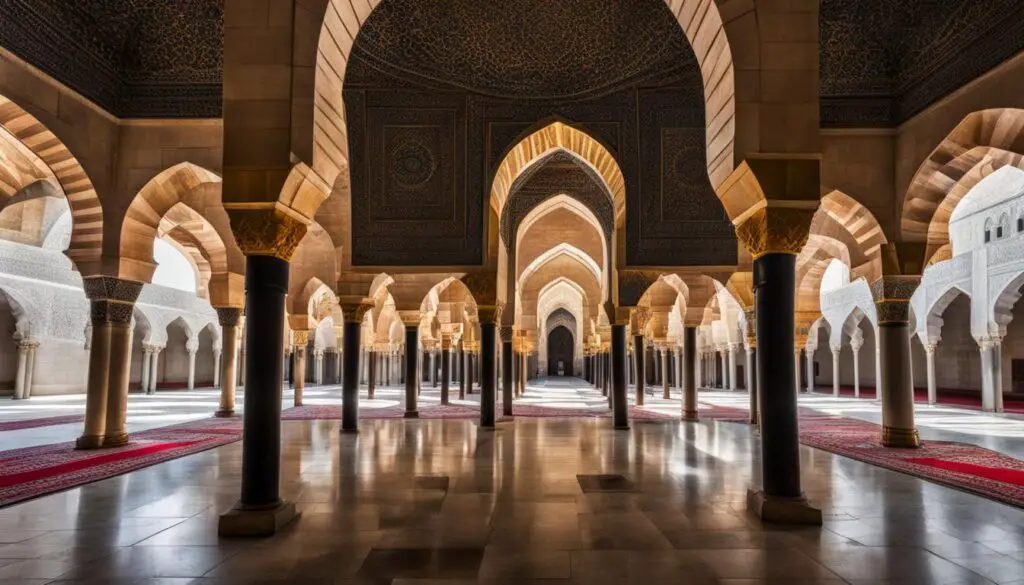
With its ancient charm preserved amidst the challenges of the modern world, Damascus continues to enthrall visitors with its architectural marvels and historical significance.
Damascus Today
Despite the ongoing conflicts in Syria, Damascus remains a cultural and historical hub, attracting tourists from around the world. This ancient city continues to captivate visitors with its unique charm and architectural wonders. From exploring bustling markets to visiting historical sites, there is much to see and experience in Damascus.
The city’s rich history and cultural heritage are evident in its well-preserved ancient buildings and landmarks. The Umayyad Mosque, built in the 8th century, is a testament to the architectural brilliance of that era. Its intricate design and stunning mosaic artwork leave visitors in awe. Damascus itself is recognized as a UNESCO World Heritage Site, further highlighting its significance as a tourist destination.
One cannot overlook the resilience and spirit of the people of Damascus. Despite the challenges they face, they continue to preserve their cultural identity and traditions. The city’s vibrant cultural scene showcases traditional music, dance, and theater, reflecting the diverse influences that have shaped the region over centuries. Local artisans, known for their craftsmanship, produce exquisite ceramics, textiles, and jewelry, adding to the city’s artistic heritage.
As the situation in Syria stabilizes, Damascus looks to the future with a balance of modern development and the preservation of its historical character. With ongoing preservation projects and international recognition as a UNESCO World Heritage Site, the city aims to showcase its ancient beauty while embracing progress. Damascus remains a mesmerizing destination for travelers seeking to immerse themselves in the wonders of the past while experiencing the vibrant culture of the present.
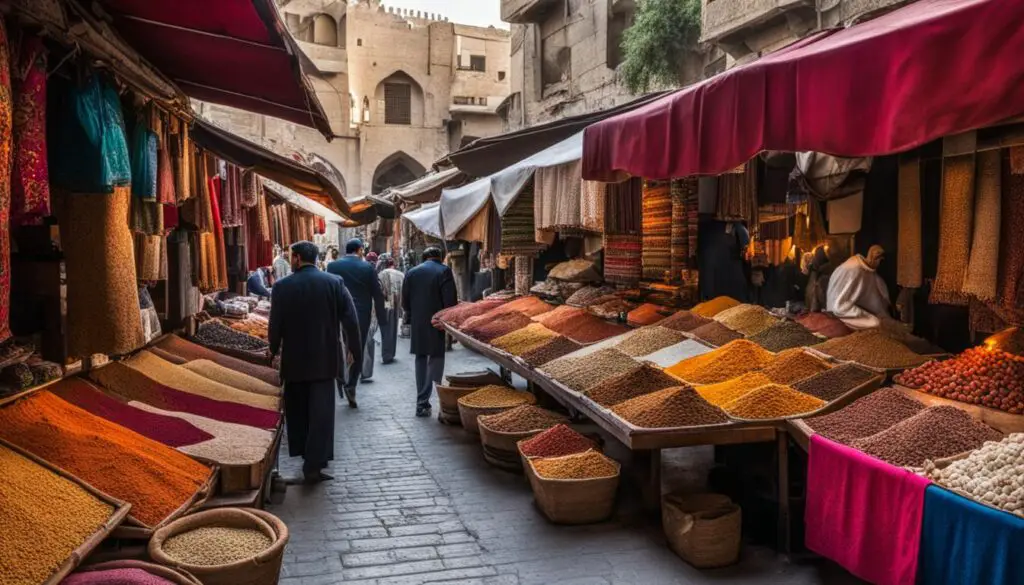
Damascene Steel and Craftsmanship
One of the most renowned aspects of Damascus is its Damascene Steel, which holds a rich history and a legacy of exceptional craftsmanship. Damascene Steel, also known as Damascus Steel, is a type of steel that is revered for its exceptional quality and distinctive patterns. It has been a symbol of Damascus’ craftsmanship for centuries.
The production of Damascene Steel involves a meticulous process of layering and forging different types of iron and steel together. This technique creates the characteristic wavy patterns that are synonymous with Damascene Steel. The intricate and skilled craftsmanship required to produce this steel has been passed down through generations, making Damascus a center for traditional craftsmanship.
Not only is Damascene Steel known for its unique aesthetic, but it also possesses exceptional strength and durability. Historical accounts suggest that swords made from Damascene Steel were highly sought after for their superior quality and performance in battle. The reputation of Damascene Steel spread far and wide, influencing the demand and trade of this prized material.
Today, the legacy of Damascene Steel lives on in Damascus. Skilled artisans continue to practice the traditional techniques of forging and shaping this iconic steel, preserving its cultural significance. The craftsmanship extends beyond swords to other forms of art and craftsmanship, including ornamental objects, jewelry, and intricate lacework.
| Advantages of Damascene Steel | Distinctive Patterns |
|---|---|
|
 |
Cultural and Artistic Traditions in Damascus
Damascus, with its rich history and cultural heritage, is a city that embodies a vibrant and diverse artistic tradition. From music to theater, dance to handicrafts, Damascus’s cultural traditions continue to flourish, showcasing the creativity and skill of its people.
Traditional Music, Dance, and Theater
The city of Damascus resonates with the melodies of traditional music, which holds a special place in its cultural fabric. The sounds of the oud, qanun, and ney fill the air, a testament to the deep-rooted musical heritage of the region. Traditional dance forms, such as the Dabke, captivate audiences with their rhythmic footwork and energetic performances. In addition, Damascus nurtures a thriving theater scene, with local playwrights, actors, and directors putting on captivating performances that showcase the diversity of artistic expression.
The Art of Craftsmanship
Damascus is renowned for its exquisite handicrafts, which have been perfected through generations of skilled artisans. The city’s bustling markets are filled with stalls selling beautifully crafted ceramics, textiles, and jewelry. The intricate designs, vibrant colors, and attention to detail are a testament to the craftsmanship and creativity of the local artisans. These handicrafts not only serve as stunning decorative pieces but also reflect the cultural heritage of Damascus, preserving traditions that have been passed down through centuries.
“The artistic traditions of Damascus are a testament to the city’s rich history and cultural diversity. From the intricate mosaics of the Umayyad Mosque to the captivating performances of traditional music and dance, Damascus continues to inspire with its artistic heritage.” – Local Artisan
Preserving and Celebrating Cultural Heritage
The people of Damascus take great pride in their cultural heritage and are dedicated to preserving and celebrating it. Festivals and events throughout the year provide a platform for artists, musicians, and craftsmen to showcase their talents and share their artistic traditions with locals and visitors alike. These initiatives not only contribute to the cultural vibrancy of the city but also serve as a means of promoting intercultural dialogue and understanding.
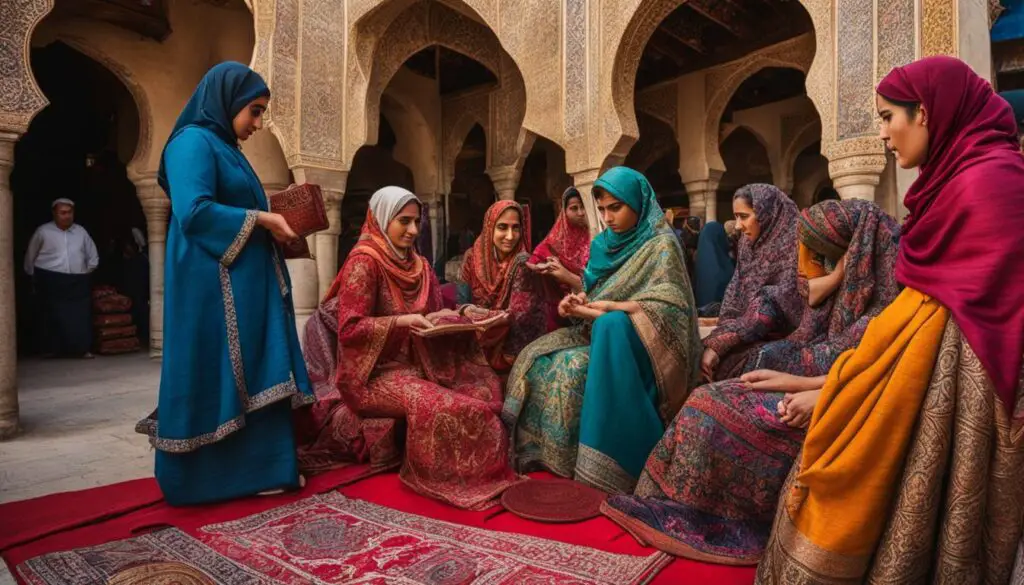
| Traditional Music | Traditional Dance | Theater | Craftsmanship |
|---|---|---|---|
| Enthralling melodies of the oud, qanun, and ney | Energetic performances of the Dabke | Captivating plays and performances | Exquisite ceramics, textiles, and jewelry |
| A reflection of deep-rooted musical heritage | Preserving traditional dance forms | Embracing diverse forms of expression | Showcasing the skill and creativity of artisans |
| Evoking emotions and cultural identity | Celebrating the region’s rich cultural tapestry | Engaging audiences through storytelling | Preserving traditions passed down through generations |
Preservation and Recognition of Damascus
The historical and architectural heritage of Damascus is of immense value and significance. Efforts have been made to preserve and protect this ancient city for future generations. One of the key recognitions of Damascus is its designation as a UNESCO World Heritage Site, highlighting its global importance and the need for its safeguarding.
Damascus, as a UNESCO World Heritage Site, benefits from international recognition and support. This status brings attention to the city’s cultural and historical treasures, fostering a collective responsibility for their preservation. Ongoing projects focus on conserving and restoring important sites, such as the Umayyad Mosque and other significant landmarks, to ensure their integrity and longevity.
“The preservation and recognition of Damascus as a UNESCO World Heritage Site is vital for protecting the city’s ancient beauty and preserving its history for future generations.”
Various organizations and stakeholders are actively involved in these preservation efforts. They work in collaboration with local communities, employing expertise in historical conservation and urban planning. By blending modern needs with the preservation of historical character, they aim to create a sustainable future for Damascus while respecting its unique identity.
| Preservation and Recognition of Damascus | Benefits |
|---|---|
| UNESCO World Heritage Site designation | Highlights global importance and promotes awareness |
| International recognition and support | Brings attention and resources for preservation projects |
| Collaboration with organizations and stakeholders | Brings expertise in historical conservation and urban planning |
| Preserving historical sites and landmarks | Ensures their integrity and longevity |
| Creating a sustainable future | Blending modern needs with historical preservation |
The preservation efforts for Damascus go beyond physical conservation. They also encompass the promotion of cultural awareness and education. Programs are designed to engage the local community and visitors, fostering a sense of pride and responsibility for the city’s heritage. By understanding and appreciating the significance of Damascus, it is hoped that future generations will continue to cherish and protect this unique historical gem.
Challenges and Resilience
Damascus, like many ancient cities, has faced its fair share of challenges throughout its history. From invasions to conflicts and political instability, the city has endured hardships that have tested the resilience of its people. However, despite these challenges, Damascus has managed to preserve its cultural identity and heritage, remaining a symbol of endurance and strength.
Throughout the centuries, Damascus has been a witness to numerous invasions and conflicts. From the conquests of the Assyrians, Persians, Greeks, and Romans to the more recent turmoil in the region, the city has experienced periods of turmoil and destruction. Yet, despite the devastation, the people of Damascus have managed to rebuild their lives and the city, showcasing their unwavering spirit and determination to preserve their heritage.
The resilience of Damascus is not only reflected in the physical reconstruction of the city but also in its cultural heritage. Despite the challenges they face, the people of Damascus continue to celebrate their traditional arts, crafts, and cultural traditions. From music and dance to theater and handicrafts, the city’s vibrant cultural scene is a testament to the resilience and creativity of its inhabitants.
Furthermore, the people of Damascus have shown remarkable strength in preserving their sense of community and social cohesion. In the face of adversity, they have come together to support one another and maintain their rich cultural traditions, demonstrating the power of unity and resilience.
Modern Development and Future Outlook
Damascus, a city rich in history and cultural heritage, is also looking towards the future with modern development projects and ambitious plans. As the situation in Syria stabilizes, the city aims to strike a balance between preserving its ancient beauty and embracing progress for a brighter future.
One of the key areas of modern development in Damascus is infrastructure improvement. The city is investing in upgrading its transportation systems, including roads, public transportation, and airports, to enhance connectivity and facilitate easier access for tourists and residents alike. These improvements will not only benefit the local population but also contribute to the growth of the tourism industry, which plays a vital role in Damascus’ economy.
In addition to infrastructure, urban revitalization projects are underway to breathe new life into the city. Efforts are being made to restore and revitalize historical buildings and neighborhoods, preserving the unique architectural charm of Damascus while creating vibrant spaces for residents and visitors to enjoy. These projects aim to enhance the quality of life in the city while also attracting more tourists and investors.
Looking to the future, Damascus envisions itself as a modern city that showcases its ancient beauty and cultural heritage. The city’s modern development initiatives, combined with its rich historical offerings, create a unique blend that appeals to both locals and international visitors. As Damascus continues to evolve and adapt, it remains a symbol of resilience and endurance, ready to embrace the opportunities that lie ahead.
Development Projects in Damascus
| Project | Description |
|---|---|
| Transportation Upgrades | Investment in improving roads, public transportation, and airports for better connectivity and accessibility. |
| Urban Revitalization | Restoration and revitalization of historical buildings and neighborhoods to create vibrant spaces for residents and tourists. |
| Tourism Expansion | Efforts to attract more tourists through marketing campaigns and the development of tourist-friendly infrastructure. |
| Economic Diversification | Promoting investment in industries beyond tourism to foster economic growth and sustainability. |
| Preservation of Cultural Heritage | Continued commitment to safeguarding and preserving Damascus’ cultural treasures for future generations. |
Conclusion
Damascus, with its ancient beauty and rich cultural heritage, stands as a timeless city that captivates visitors from around the world. This historical gem has a significant biblical importance, as it is mentioned several times in the Bible. Notable biblical figures such as Abraham, Elijah, and Saint Paul are linked to the city, adding to its religious significance.
In biblical times, Damascus flourished as a vibrant city with a thriving craft industry. It was renowned for its sword production and lace craftsmanship, which contributed to its economic prosperity. The city’s Assyrian sanctuary later became the site of the magnificent Umayyad Mosque, a testament to the impressive architecture and ancient landmarks found in Damascus.
Major biblical events, such as the conversion of Saint Paul to Christianity, took place in Damascus, leaving a lasting impact on its history. The city played a vital role in the spread of Christianity and the development of early Christian communities. Today, despite the ongoing conflicts in Syria, Damascus remains a cultural and historical hub, attracting tourists who are drawn to its ancient charm.
Damascus continues to preserve its cultural and artistic traditions, with a vibrant cultural scene that showcases traditional music, dance, and theater. Local artisans contribute to the city’s artistic heritage by producing exquisite handicrafts. Efforts have been made to preserve Damascus’ historical and architectural treasures, with international recognition as a UNESCO World Heritage Site.
FAQ
Is Damascus one of the oldest cities in the Middle East?
Yes, Damascus is one of the oldest cities in the Middle East, founded in the 3rd millennium B.C.
What is the biblical significance of Damascus?
Damascus holds biblical importance as it is mentioned several times in the Bible and has been linked to notable biblical figures such as Abraham, Elijah, and Saint Paul.
What role did Damascus play in biblical times?
Damascus was a thriving city with a flourishing craft industry and played a significant role in the spread of Christianity after the conversion of Saint Paul.
What are some major biblical events that took place in Damascus?
One major biblical event was the conversion of Saint Paul to Christianity, which had a lasting impact on the history of Damascus.
What are some architectural landmarks in Damascus?
The Umayyad Mosque, built in the 8th century, is one of the most spectacular landmarks in the city and is known for its intricate design and stunning mosaic artwork.
Is Damascus still a popular tourist destination?
Despite ongoing conflicts in Syria, Damascus remains a cultural and historical hub, attracting tourists from around the world who are drawn to its ancient beauty and cultural heritage.
What is Damascene Steel?
Damascene Steel is a type of steel known for its exceptional quality and distinctive patterns, which is produced in Damascus.
Is there a vibrant cultural scene in Damascus?
Yes, Damascus has a vibrant cultural scene, with a rich artistic heritage, including traditional music, dance, theater, and exquisite handicrafts.
Are there efforts to preserve the historical heritage of Damascus?
Yes, Damascus is recognized as a UNESCO World Heritage Site, and various organizations and stakeholders are actively involved in safeguarding the city’s cultural treasures for future generations.
How has Damascus demonstrated resilience throughout history?
Despite facing numerous challenges, including invasions, conflicts, and political instability, the city has demonstrated remarkable resilience, with its inhabitants preserving their cultural identity and heritage.
Is there modern development in Damascus?
Yes, recent years have seen modern development in Damascus, including infrastructure improvements and urban revitalization projects, aiming to balance modernization with the preservation of its historical character.
What makes Damascus a unique destination?
Damascus remains a timeless city where history and culture intertwine, offering visitors the opportunity to immerse themselves in the wonders of the past through its ancient architecture, vibrant markets, and captivating stories.


